Another Spring Tour today, and this time the plan was to investigate the coast around Holkham and Titchwell.
We headed over to Holkham to start. It was beautifully sunny in the morning, and warm at times out of the wind. As we got out of the car at Lady Anne’s Drive, a Whimbrel flew overhead, the first of several spring migrants we were to see today, and disappeared off east. We headed west, walking along the path on the inland side of the pines.
The warblers were in full voice. From the deciduous trees alongside the path, we heard and saw Blackcap, Whitethroat and Lesser Whitethroat, Chiffchaff and Willow Warbler. In the reeds we could hear several Reed and Sedge Warblers and the explosive song of Cetti’s Warbler. There was also the usual selection of tits and others along the edge of the pines – including Coal Tits, Treecreeper and Goldcrest.
Most of the wintering Pink-footed Geese left in February, but a small group have still been lingering on the grazing marshes. As we approached Meals House, we saw thirty of them fly in and land on the grass, where we could get them in the scope. A family group of Greylag Geese walked right past them, giving a great comparison between the two species.
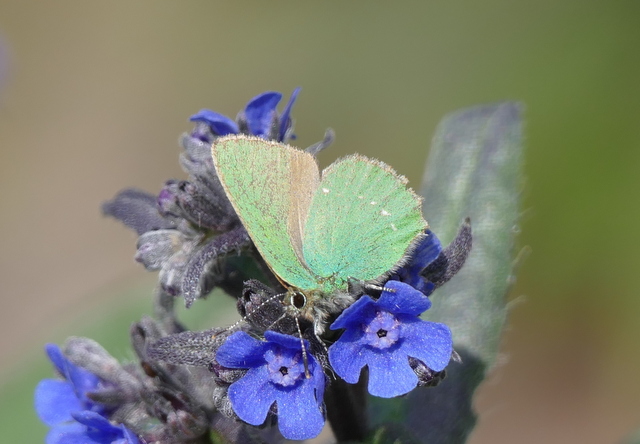 Green Hairstreak – feeding on Green Alkanet flowers
Green Hairstreak – feeding on Green Alkanet flowers
There is a little patch of blue-flowered Green Alkanet by Meals House at the moment, which has been alive with butterflies. Today was no exception. There were a couple of shiny Green Hairstreaks, Holly Blues, a very smart Orange Tip and Green-veined White. We paused to admire them, and get some photos.
 Holly Blue – a female, with black-bordered forewings
Holly Blue – a female, with black-bordered forewings
Our next stop was at the Joe Jordan Hide. There was no sign of our main target initially, so we contented ourselves with admiring the Marsh Harriers and Buzzards. A pair of Grey Partridge fed quietly in the grass down below the hide. A Cuckoo flew over from the dunes and circled the trees, before flying back and disappearing into a Hawthorn bush. We could hear it calling pretty much constantly all the time we were in the hide from then on.
Finally, a Spoonbill dropped out from the trees and down onto the pool in front. It disappeared into the rushes, before re-emerging and having a bathe. Then in stood on the front edge of the pool to preen. We got a good look at it through the scope. A second Spoonbill also flew down and initially seemed interested in trying to gather nest material, before losing interest and starting to feed instead.
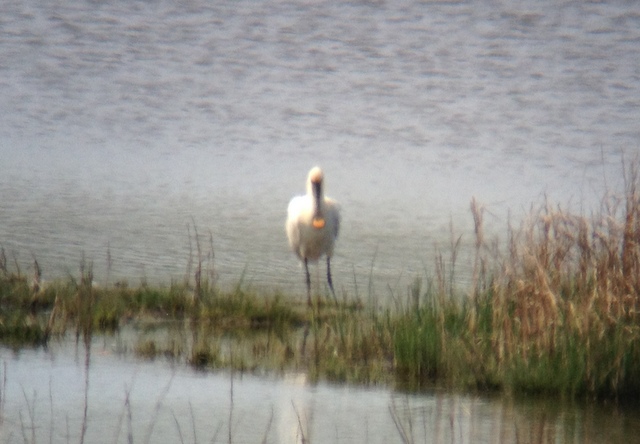 Spoonbill – at least two were around the pool today
Spoonbill – at least two were around the pool today
From there, we headed into the dunes. At first, they seemed a little quiet. We could hear the Cuckoo again in the bushes, but couldn’t see it at first. Then an agitated Meadow Pipit pointed it out to us, half hidden in the top of a sallow and we saw it fly across to a low bramble clump where it landed and we got it in the scope. The Meadow Pipit set off after it and quickly chased it off again.
Finally we found a couple of Wheatears, a male and a female, but they were rather flighty and quickly disappeared up and over the dunes. That at least was the start of something and a little further on we found a Ring Ouzel as well. We nearly walked past it – a glimpse of something brownish disappearing round behind a bush could just as easily have been one of the many rabbits, but when we followed it up, a female Ring Ouzel flew out calling.
Just beyond, we found yet more Wheatears and this time a more confiding male, which perched up for the scope and even for the cameras. Once again, the males today were large and sporting quite a bit of orangey colour on the throat and upper breast, indicating they were Greenland Wheatears on their long journey north and west.
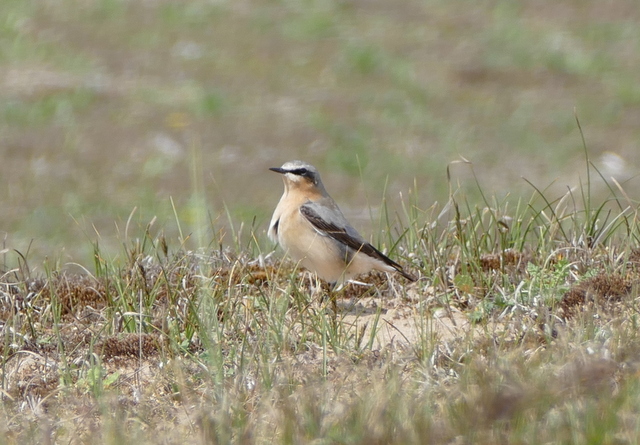 Greenland Wheatear – there were several in the dunes today
Greenland Wheatear – there were several in the dunes today
A report of a Tree Pipit earlier at Gun Hill saw us continuing even further west. There was no sign of it when we got there, but we did stop to admire the Little Terns feeding just offshore in the channel. The dunes towards Gun Hill were heaving with Linnets, including some very smart males with rusty backs and increasingly pink throats. There were fewer Yellow Wagtails moving today than there had been in recent weeks, but as we walked back one flushed from the dunes and disappeared off west. Small numbers of Swallows were still moving west through the dunes.
We saw a couple of smart Small Copper butterflies as well in the dunes, our first of the year. And there were several Cinnabar Moths, their bright pinky-red underwings flashing a warning as they flew.
 Small Copper – several in the dunes today
Small Copper – several in the dunes today
We were almost back to Lady Anne’s Drive when we heard the distinctive reeling of a Grasshopper Warbler from out in the bushes amongst the reeds. Unfortunately, we couldn’t see it from the path. Then it was time to get back for lunch.
In the afternoon, we headed west to Choseley. There have been a variable number of Dotterel in the same field there for around two weeks now. We couldn’t find them at first, when we arrived today. We scanned the field, but only produced a few Wheatears, Skylarks, Red-legged Partridges and Brown Hares. However, the Dotterel have a remarkable ability to simply disappear and when they sit down they merge with the stony ground. Eventually, one stood up and we were onto them, quickly finding the other six nearby as the whole trip started running around the field feeding. They were quite close to the hedge today and by positioning ourselves by a convenient gap we got some really good views. Stunning birds.
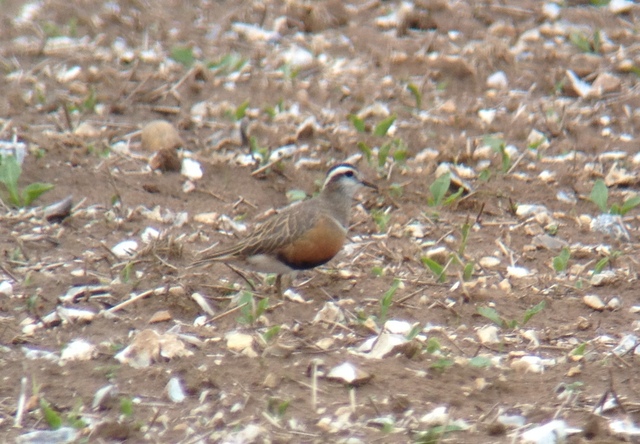
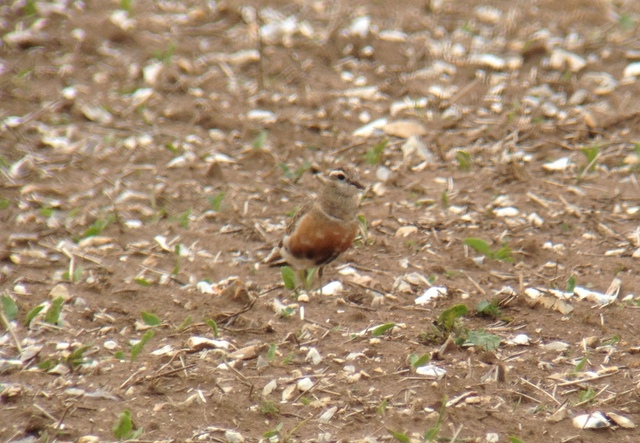 Dotterel – the trip of 7 showed really well at Choseley this afternoon
Dotterel – the trip of 7 showed really well at Choseley this afternoon
We swung round via the drying barns and, along the road side, we found a little group of Yellowhammer feeding in a weedy field. In amongst them was a larger, paler, browner bunting – a Corn Bunting. A smart pair of Stock Doves were feeding nearby, next to a Woodpigeon to allow a close comparison.
From Choseley, we dropped down to Titchwell. We were a little later than we would normally have been getting there, but we still wanted to have a quick look around the reserve. The weather was deteriorating and it had clouded over -the forecast had been for showers this afternoon, and we were possibly fortunate it had held off so long.
The first bird of note was a Red-crested Pochard in one of the channels in the reedbed. A Great Crested Grebe was on the reedbed pool, resplendent in its summer plumage. Lots of Sedge and Reed Warblers were singing from the reeds.
The first bird we saw as we entered Island Hide was a bit of a surprise. A drake Greater Scaup was swimming out on the water – rather like a large Tufted Duck, with a grey back and green-glossed head. We just got the scope on it when it took off and flew away towards the sea.
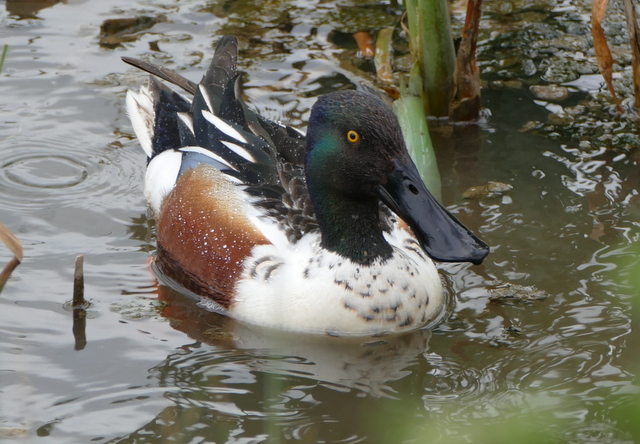 Shoveler – sporting its very large bill
Shoveler – sporting its very large bill
There was a good selection of other ducks out on the freshmarsh too – Gadwall, Mallard and Shoveler. There are also still a few Teal present, though numbers continue to drop. Several Brent Geese flew in from the saltmarsh briefly to bathe.
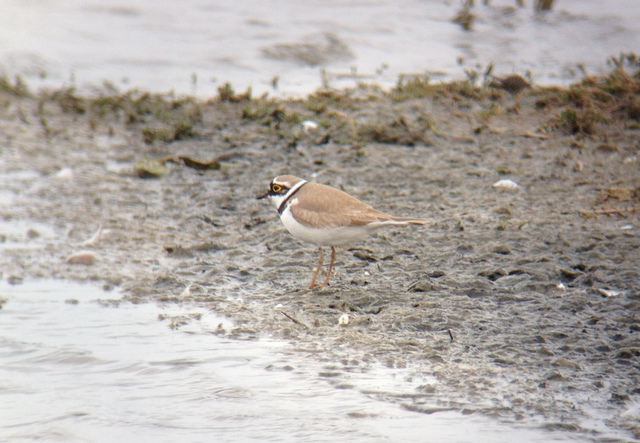 Little Ringed Plover – showing off its golden-yellow eye ring
Little Ringed Plover – showing off its golden-yellow eye ring
There weren’t so many waders as in recent weeks. A couple of Little Ringed Plover on the islands, with one in particular quite close giving us a great look at its golden-yellow eye ring. We found first one, then two Common Sandpipers working their way surreptitiously round the islands, bobbing nervously. Only 2-3 Black-tailed Godwit today, which dropped in, a single Dunlin moulting into summer plumage, and a Whimbrel flew over. And lots of Avocets as usual.
 Avocet – no trip to Titchwell is complete without a photo!
Avocet – no trip to Titchwell is complete without a photo!
By now it was starting to rain, but thankfully only lightly, still not as bad as had been forecast and it didn’t put us off. There were not so many waders on the Volunteer Marsh or the tidal pools either. However, on the latter, we found the Scaup again amongst a group of Pochard. This time we got a really good, long look at it through the scope.
 Greater Scaup – this drake was the surprise at Titchwell today
Greater Scaup – this drake was the surprise at Titchwell today
We were running out of time now, but we managed a quick look on the beach. The tide was out and there were plenty more waders out here. The Grey Plovers caught the eye first, with a couple of them resplendent in their summer plumage with black bellies and faces. There were several Bar-tailed Godwits on the beach, mostly in winter attire but with one very rusty-coloured bird. The Turnstones were also living up to their proper name of Ruddy Turnstone, looking stunning with their rufous backs and white faces, with a single Ringed Plover hiding in amongst them. Several Sanderling were running along the shore.
Then it was unfortunately time to call it a day – but what a productive day it had been again.
















